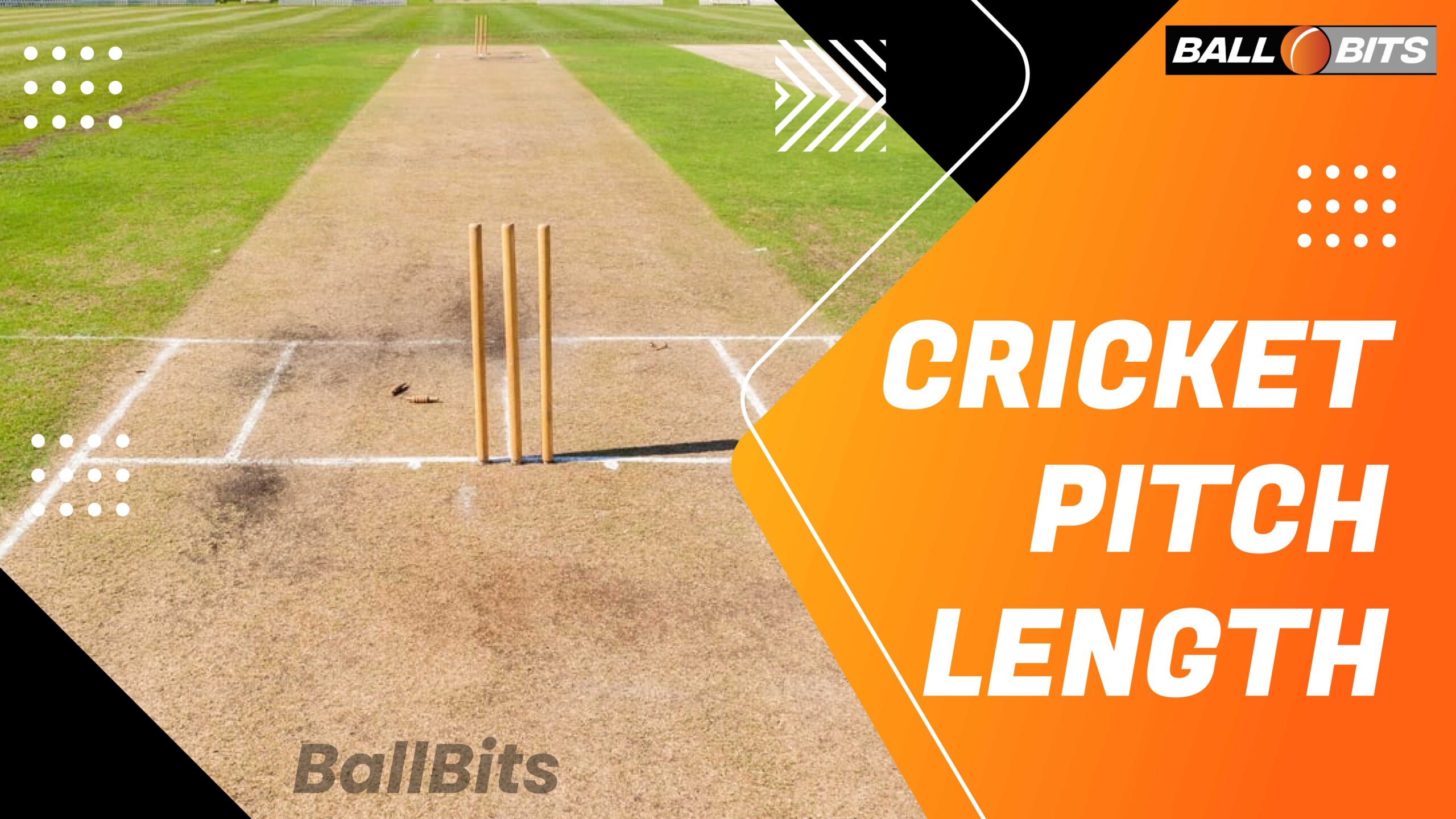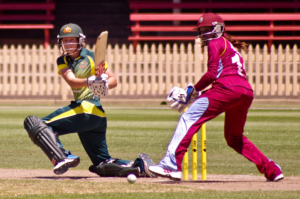
Cricket, often described as a game of skill, strategy, and patience, revolves around a seemingly unassuming yet vital component—the cricket pitch.
This strip of turf holds the key to the outcome of a cricket match, affecting the performance of both batsmen and bowlers.
In this article, we aim to delve into the heart of the game by providing readers with essential information about cricket pitch length, a factor often underestimated in its significance.
The Basics of a Cricket Pitch
At its core, a cricket pitch is the rectangular area where most of the game’s action unfolds. Its dimensions are standardized, measuring 22 yards (20.12 m) in length.
The width of the pitch is 10 feet (3.05 m), and it serves as the battleground for the bowler and the batsman.
It is a precisely defined strip in the centre of the playing field, and it is essential for the outcome of a cricket match.
The standardized measurements ensure a level playing field, allowing for fair competition.
Why is a cricket pitch exactly 22 yards long?
To understand this, we must journey back to the roots of cricket.
The 22-yard pitch originated in the 18th century when the Hambledon Club, a famous cricket club in England, established this length as the standard.
It was believed to provide a fair balance between the batting and bowling aspects of the game.
Since then, this pitch length has become a defining characteristic of cricket and remains unchanged, carrying historical significance that adds depth to the game.
Pitch Preparation and Maintenance
Pitch preparation is a fine art, as the condition of the pitch can significantly impact the game.
Groundsmen play a crucial role in crafting pitches that balance the interests of both bowlers and batters.
Techniques such as rolling, watering, and mowing are used to ensure that the pitch is consistent and plays well.
The groundsmen’s expertise and attention to detail are vital to maintaining a pitch that challenges the players while still providing a fair platform for competition.
Variations in Cricket Pitch Length
Different formats of cricket, such as Test matches, One Day Internationals (ODIs), and Twenty20 (T20) games, have unique demands.
Test matches typically use pitches with longer grass and more moisture, making them conducive to swing and seam movement for bowlers.
In contrast, T20 pitches are generally flat and hard, favoring batters as batting-friendly pitches have even bounce and true carry, making it easier for batters to score runs.
Turners are tailor-made for spinners, with the surface aiding sharp turns.
Weather conditions, such as rain, can alter the pitch dynamics, making it difficult to predict how it will behave throughout a match.
Pitch Inspection and Umpire’s Role
Before every match, a rigorous pitch inspection takes place to ensure fair play.
Umpires meticulously examine the pitch’s surface, its hardness, and any irregularities.
They make sure the safety of the players and that the pitch adheres to the rules.
This process is critical for the integrity of the game, as it ensures that neither team gains an unfair advantage due to pitch conditions.
The Impact of Cricket Pitch Length on Strategy
Understanding variations in cricket pitch length and conditions is crucial for teams to adapt their strategies and select the right players for each format.
In Test matches, for instance, a team might opt for a lineup dominated by spinners if they anticipate a turning pitch.
Conversely, they might select more pace bowlers on a seam-friendly pitch.
Famous matches, such as the “Laker’s match” at Old Trafford or the “Turning Track Test” in Mumbai, have seen pitch conditions playing a crucial role in determining the outcome and leaving a lasting impact on cricket history.
Pitch Evolution Through the Ages
Cricket pitch length has undergone a fascinating evolution over the centuries. In the early days of cricket, the pitch was not standardized to the 22 yards we know today.
Instead, various materials were used to create pitches, including rolled turf, matting, and even sand.
These diverse materials influenced the way the game was played, with each surface offering unique challenges to both batsmen and bowlers.
As the sport developed, pitch preparation and maintenance techniques improved.
Groundsmen, often unsung heroes of cricket, played an increasingly important role in crafting the perfect pitch.
Their expertise in soil composition, grass management, and drainage systems has been crucial in creating consistent and fair playing surfaces.
Pitch Preparation Challenges
Preparing a cricket pitch is no small feat. Groundsmen face numerous challenges, starting with the unpredictable weather.
They must balance the needs of both batsmen and bowlers, aiming for a pitch that is neither too flat nor too difficult to bat on.
The pressure to meet the expectations of players and spectators can be immense.
In international matches, there’s an expectation for pitches to provide a balance between bat and ball.
However, this balance can shift based on the preferences of home teams and groundsmen, creating a debate over the ethics of pitch preparation.
Additional Insights
This section provides information that would help you get a deeper understanding of the multifaceted world of cricket pitches.
Pitch Microclimates
Cricket grounds and stadiums worldwide have their unique microclimates. These microclimates contribute to the distinct pitch characteristics found at various venues.
For example, subcontinental pitches are renowned for being conducive to spin due to the warm and dry conditions.
In contrast, Australian pitches are known for their extra bounce and pace, thanks to the climate and soil conditions.
The microclimate of each cricket ground impacts how the pitch behaves during a match.
Teams must factor in these variations when strategizing and selecting their playing XI.
Impact of Day-Night Matches
The advent of day-night matches, played under artificial lighting, has introduced a new dimension to cricket and has had an impact on pitch conditions.
The use of pink cricket balls in these matches is a significant change, as they behave differently under lights compared to traditional red balls.
Day-night cricket has seen pitches respond differently at different times of the day, creating challenges for both batsmen and bowlers.
Understanding these changes is crucial for teams to adapt to the shifting conditions effectively.
Grass Varieties
The choice of grass varieties on a cricket pitch is another fascinating aspect.
Different grass types have unique characteristics that can significantly influence pitch behavior.
For instance, some grasses provide extra bounce and pace, while others encourage spin.
Pitch Technology and Analysis
Modern cricket has seen the integration of technology in pitch analysis.
Pitch maps and Hawk-Eye technology are used to gather data on pitch conditions and behavior during a match.
This data is invaluable for teams in formulating their match strategies and tactics.
Teams can use technology to analyze how the pitch changes over time, helping them make informed decisions during a game.
The integration of technology in pitch analysis has added a new layer of depth to the understanding of pitch conditions.
Famous Pitch Controversies
The history of cricket is not without its share of pitch-related controversies.
From accusations of pitch manipulation to matches marred by poor pitch conditions, these incidents have sparked debates and, in some cases, led to rule changes.
These controversies are a testament to the critical role that pitch conditions play in the integrity of the game.
Let us look at some of them below:
Nagpur Pitch Controversy (2004):
During the fourth Test of India’s series against Australia in 2004, the Nagpur pitch drew widespread criticism.
The pitch was slow and low, making it extremely difficult for batsmen to score runs.
Australia was bowled out for a mere 93 runs, while India managed just 190 in their first innings.
The match ended within three days, and critics argued that the pitch favored the home team.
This controversy prompted discussions about pitch preparation and its impact on the fairness of Test matches.
South Africa vs. India Pitch Controversy (2018):
In a Test match between South Africa and India at the Newlands cricket ground in Cape Town in 2018, the pitch came under scrutiny.
The surface was challenging for batting, with the ball moving extravagantly. Some critics argued that the pitch made it almost impossible for the batsmen to survive.
However, others defended it as a fair Test wicket, highlighting the importance of seam and swing in cricket.
Galle Pitch Controversy (2019):
A Test match between Sri Lanka and New Zealand at the Galle International Stadium in 2019 raised concerns about the condition of the pitch.
The surface deteriorated rapidly, leading to exaggerated turn and variable bounce, making it almost impossible for the batsmen.
New Zealand struggled in both innings, and the match ended within four days. The Galle pitch controversy reignited discussions about pitch preparation and its impact on the outcome of Test matches.
Ahmedabad Pitch Controversy (2021):
During the third Test between India and England at the Narendra Modi Stadium (formerly Sardar Vallabhbhai Patel Stadium) in Ahmedabad in 2021, the pitch was heavily criticized.
The surface provided substantial turn and bounce from the very beginning, favoring the spin bowlers.
The Test ended within two days, with many batsmen struggling to stay at the crease. The pitch’s extreme conditions led to debates about whether it was suitable for a Test match.
The Future of Cricket Pitches
As cricket continues to evolve, so does the technology and innovation surrounding pitch preparation.
Emerging technologies and materials could potentially change the way pitches are constructed and maintained.
In this section, we’ll delve into the potential advancements and their implications for the future of cricket pitches.
- Smart Pitches: One of the most exciting developments is the concept of “smart pitches.” These are equipped with sensors and technology that can provide real-time data on pitch conditions, including moisture levels, temperature, and wear and tear. Smart pitches can potentially revolutionize the game by offering precise insights to players, coaches, and groundsmen, enabling them to adapt their strategies on the fly.
- Pitch Surface Materials: Innovations in pitch surface materials may lead to more consistent and durable pitches. Materials that mimic natural grass could become more prevalent, reducing the need for extensive pitch preparation and maintenance. These artificial surfaces could offer enhanced playability while minimizing the impact of weather conditions.
- Climate-Adaptive Pitches: As climate change continues to affect weather patterns, cricket pitches may need to adapt. Pitches designed to cope with extreme weather conditions, such as prolonged heatwaves or heavy rainfall, could become a necessity. These climate-adaptive pitches might incorporate advanced drainage systems or even materials that can withstand extreme temperatures.
- Pitch Customization: With advanced technology, the customization of pitches could become more precise. Groundsmen may gain greater control over pitch characteristics, allowing them to create conditions that suit the preferences of both teams. While this offers exciting possibilities, it raises ethical questions about pitch manipulation and the balance between bat and ball.
- Sustainable Pitch Management: Sustainability is a growing concern in sports. In the future, pitches may need to be designed with eco-friendly principles in mind. It could involve the use of recycled materials, energy-efficient technologies, and water-saving measures. Sustainable pitch management not only benefits the environment but also contributes to the long-term viability of the game.
- Pitch Analysis and Predictive Modeling: Advanced data analytics and predictive modeling could become integral in pitch preparation. By analyzing historical pitch data and environmental factors, groundsmen may be able to predict how a pitch will behave, allowing them to make informed decisions in advance of a match. It could lead to even more strategic play and preparation.
- Challenges and Opportunities: The transition to new pitch technologies and materials will require investment and adaptation. Groundsmen and teams may need to acquire new skills and knowledge to make the most of these advancements. Moreover, there will be ongoing discussions and debates about fairness and balance in the game, particularly in instances where pitch customization goes to extremes.
In conclusion, cricket pitch length is a fascinating aspect of the game that deserves a closer look.
By understanding the ten essential things about cricket pitch length, fans and players alike can deepen their appreciation and knowledge of this crucial element of cricket and the intricacies it adds to the sport.
Whether you’re a novice or a seasoned cricket enthusiast, these insights provide a richer understanding of the game’s complexity and the role that pitch length plays in shaping cricket’s unique challenges and strategies.
Also check out cricket umpire course







